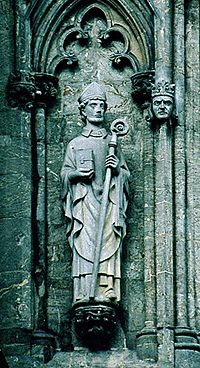St. Swithun’s day if thou dost rain,
For forty days it will remain.
St. Swithun’s day if thou be fair,
For forty days ’twill rain nae mare.* [*no more]
If on St. Swithun’s day it really pours,
You’re better off to stay indoors.
Who Was St. Swithun?
Saint Swithun was born in the reign of King Egbert of Wessex, and was ordained a priest by Helmstan, bishop of Winchester (838 – 852). He was consecrated by Archbishop Ceolnoth and remained Bishop of Winchester from October 30th, 852, until his death, 11 years later, on July 2nd, 863.
More than a hundred years later, when Dunstan and Æthelwold, latter abbot of Abingdon and bishop of Winchester; both leading figure in the tenth-century church reform movement, were inaugurating their church reform, St. Swithun was adopted as patron of their restored church at Winchester, which had been formerly dedicated to St. Peter and St. Paul. His body was transferred from its almost forgotten grave, to King Æthelwold’s new Basilica, on July 15th, 971.
St. Swithun was known for his piety and his zeal in building new churches and restoring old ones. It was at St. Swithun’s request that the aforementioned King Æthelwulf, (father of King Alfred the Great), gave a tenth part of his royal lands to the existing Church.
St. Swithun who made his diocesan journeys on foot, supposedly left instructions that his body should be buried outside the church, “ubi et pedibus praetereuntium et stillicidiis ex alto rorantibus esset obnoxius” (Translated, “where it might be subject to the feet of passers-by and to the raindrops pouring from on high”)
However, he was to be moved from his chosen grave to an indoor shrine in the Old Minster at Winchester in 971. On that day, a violent storm is said to have followed, with rain falling continuously for the next 40 days. Thus, from that story came the odd belief that the weather on July 15th, would predict either a summer of sun or a summer of rain.
The saints body was later possibly divided between a number of smaller shrines. His head was certainly detached and in the Middle Ages, taken to Canterbury Cathedral, while Peterborough Abbey got an arm.
His main shrine was transferred into the new Norman Cathedral at Winchester in 1093. He was installed on a ‘feretory platform’, latter an ornate often portable bier for the relics of a saint above and behind the high altar.
A retrochoir was built in the early 13th century to accommodate the huge numbers of pilgrims wishing to visit his shrine and enter the ‘Holy Hole’ located beneath him, often entered by the faithful, down on their hands and knees.
Æthelwold of Winchester ordered that all Monks were to stop whatever they were doing and head to the Church, to praise God every time that a miracle was brought about by St. Swithun.
The story exists that the monks at some point got so fed up of this, often forced to wake up to go to the church three or four times in a night. They decided to stop the practise. St. Swithun supposedly appeared in a dream warning them that if they stopped going to the church, then miracles would cease; resulting in the Monks deciding to return to the church, each time a miracle was known to happen.
His empty tomb in the ruins of the Old Minster became popular with visitors. The shrine was only moved into the retrochoir itself in 1476. It was demolished in 1538 during the English Reformation.
A modern representation of it now stands on the site.
Having viewed and experienced our Thurles weather today, and with Irish meteorologists promising that showers will gradually become isolated later tomorrow; with clear and dry spells developing overnight, let’s hope that the St. Swithun legend is solely a misconception.


Leave a Reply